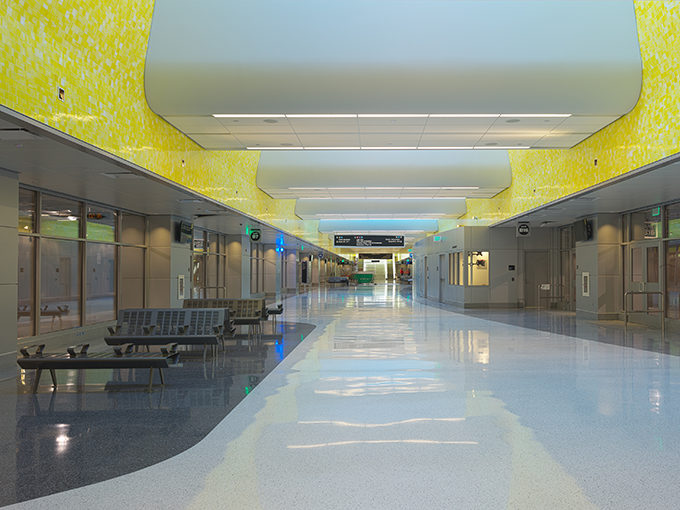
Denver, CO: Today, the Denver Regional Transportation District (RTD) will mark the opening of the Union Station Bus Concourse with a grand ribbon-cutting celebration that will include remarks from U.S. Secretary of Transportation Anthony Foxx, numerous state and local officials, RTD General Manager Phil Washington, and other dignitaries. The bus concourse is a vital component of the new Denver Union Station Intermodal Hub, the centerpiece of RTD’s FasTracks transit expansion program. Skidmore, Owings & Merrill LLP (SOM) designed the intercity bus terminal and the broader Denver Union Station complex; the firm also developed the master plan for the surrounding transit-oriented neighborhood. Service at the Union Station Bus Concourse will begin Sunday, May 11.
Denver’s historic Union Station is a Beaux Arts masterpiece located on the edge of the city’s central business district. SOM was commissioned to expand and transform this station into a major regional transportation hub. To do so, the firm converted 20 acres of former rail yards into an urban transit district that orchestrates light rail, commuter and intercity rail, bicycle and bus routes, and pedestrian pathways into an intuitive intermodal hub. The Union Station Bus Concourse is situated at the heart of this vibrant network, directly beneath the rail station.
“This project represents a major investment in transit-oriented development with extraordinarily far-reaching social and economic consequences,” states Roger Duffy, Design Partner. “The bus concourse is the result of nearly a decade of thoughtful public consultation and bold design. Its completion helps realize this community’s aspirations for a truly transformational neighborhood and landmark public project.”
Measuring 980 feet in length, the 22-gate underground bus concourse services 16 regional, express, and local bus routes. The terminal serves a dual purpose as a subterranean pedestrian concourse that connects the constellation of transportation programs distributed across the site. Vivid colors and natural lighting help passengers orient themselves, whether they are boarding buses, navigating to the light rail or commuter rail stations, or ascending into the capital city. Handsome terrazzo floors and sparkling yellow glass tilework elevate the ambience of terminal beyond the typical, often unimaginative depot experience, and a series of skylights and glass pavilions flood the hall below with daylight, infusing the station with a sense of motion and spaciousness.
The opening of the Union Station Bus Concourse marks a significant milestone in the realization of the city’s intermodal hub. Above ground, Amtrak service has returned to the station and their Zephyr trains—which zip passengers from Denver west to San Francisco and east to Chicago—now pull in beneath SOM’s soaring Train Hall canopy every day. This structure, an efficient and formally expressive means of sheltering multiple railway tracks, comprises 11 steel arch trusses spanning nearly 180 feet, clad in bright white tensioned fabric. In profile, the canopy rises 70 feet at either end and descends in a dynamic sweep to 22 feet at the center, a gesture that allows the structure to protect the passenger platforms below, while remaining clear of the view corridor established to protect views of the historic station. In addition to Amtrak service, four commuter rail lines are scheduled to open in 2016 and 2018.
A bustling, two-block-long pedestrian promenade at grade level links the Train Hall to the SOM-designed Denver Union Station Light Rail Terminal, which has carried nearly 10,000 passengers every weekday since it opened in 2012. An enhanced network of pedestrian and public spaces within and around the site now seamlessly integrates the hub into the LoDo (Lower Downtown) district to the east and newer residential neighborhoods to the south, west, and north.
One of the largest of its kind in the United States, the redevelopment of the former rail yards at Denver Union Station is a case study of the power of transit-oriented urban design. This substantial public investment has catalyzed an unprecedented wave of private-sector activity: Economists estimate that the project has already triggered more than $1 billion in private mixed-use investment on surrounding property. Sensitive to its historic location, but fundamentally forward looking in its technical sophistication and city-building spirit, Denver Union Station sets the standard for 21st-century intermodal hubs.
About Skidmore, Owings & Merrill LLP
Skidmore, Owings & Merrill LLP (SOM) is one of the leading architecture, interior design, engineering, and urban planning firms in the world, with a 75-year reputation for design excellence and a portfolio that includes some of the most important architectural accomplishments of the 20th and 21st centuries. Since its inception, SOM has been a leader in the research and development of specialized technologies, new processes and innovative ideas, many of which have had a palpable and lasting impact on the design profession and the physical environment. The firm’s longstanding leadership in design and building technology has been honored with more than 1,700 awards for quality, innovation, and management. The American Institute of Architects has recognized SOM twice with its highest honor, the Architecture Firm Award, in 1962 and again in 1996. The firm maintains offices in New York, Chicago, San Francisco, Los Angeles, Washington, D.C., London, Hong Kong, Shanghai, Mumbai, and Abu Dhabi.